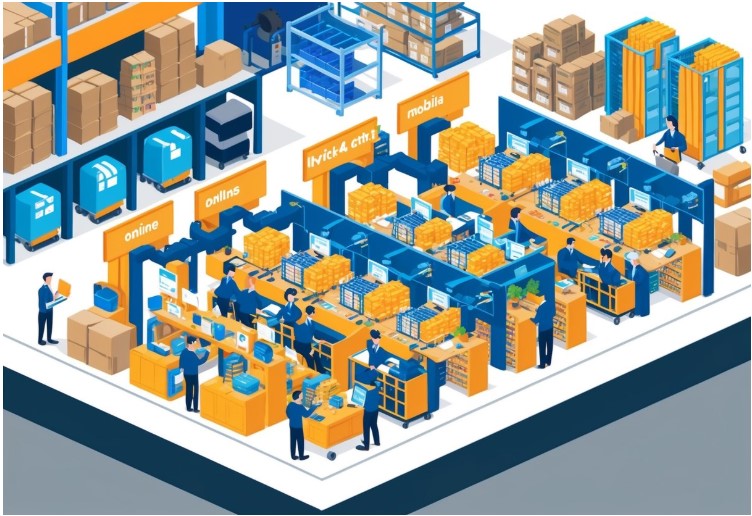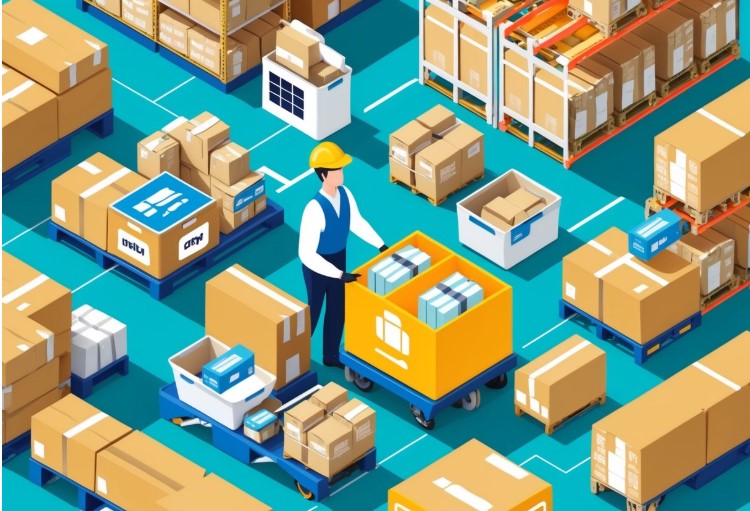Omnichannel Fulfillment: A Guide for Modern Retailers

Is your business struggling to connect physical stores, e-commerce, and marketplace sales? Omnichannel fulfillment could be the answer. This integrated approach combines inventory across all sales channels, creating a seamless experience for the customer and simplifying operations for the retailer.
Unlike traditional methods that treat each channel separately, omnichannel breaks down the silos to provide consistent service and visibility – whether the customer shops in-store, online, or through social media.
What is Omnichannel Fulfillment
Modern retail demands flexibility and consistency across all customer touchpoints.
Definition and Scope
Omnichannel fulfillment means the integrated management of inventory, orders, and customer data across all sales channels to create a unified shopping experience. Unlike multichannel fulfillment, which manages each sales channel separately, omnichannel breaks down these silos to create a system.
In a multichannel approach, a retailer might have separate inventories for their online store versus their brick-and-mortar locations. Orders from each channel are processed differently, often with disconnected systems. In omnichannel fulfillment, inventory is treated as a single pool that serves all channels at the same time.
A unified inventory and order management system is the backbone of successful omnichannel fulfillment. This central platform tracks all inventory in real-time regardless of location – whether in warehouses, distribution centers, or retail stores. When a customer places an order through any channel, the system can identify the best fulfillment location based on inventory availability, proximity to the customer, and other business rules.
Why is it Important in Modern Retail
Today’s customer expects convenience and consistency. They might research products on their phone, check availability in a local store, buy online, and pick up in person – all in a single shopping journey. Retailers without integrated systems struggle to meet these expectations and create friction that can drive customers to competitors.
Omnichannel is not just a convenience but a competitive necessity. Research shows that omnichannel customers spend 30% more than single-channel customers. These customers value the flexibility to shop when and how they want, with complete visibility into product availability and fulfillment options.
For retailers, the benefits go beyond customer satisfaction. Integrated inventory management reduces overstock and stockout situations, improves cash flow, and reduces carrying costs. Order routing optimization means faster shipments at lower cost. Data across channels provides valuable insights into customer behavior and preference,s enabling more targeted marketing and product development
Key Differences Between Omnichannel and Multichannel Fulfillment

Understanding these differences helps retailers make informed decisions about their fulfillment strategy.
Inventory Management Approaches
In multichannel fulfillment, inventory is typically siloed by channel. A retailer might have separate stock for their website, Amazon storefront, and physical locations. This approach creates several inefficiencies: duplicate inventory, increased storage costs, and the risk of stockouts in one channel while having excess inventory in another.
Omnichannel fulfillment treats all inventory as a single pool. When a customer places an order through any channel, the system can draw from the entire inventory network – whether that’s a distribution center, store backroom, or even another retail location. This approach offers several benefits:
- Reduced total inventory levels while maintaining or improving product availability
- Lower carrying costs and reduced risk of obsolescence
- Ability to leverage all physical locations as mini-fulfillment centers
- More accurate forecasting based on complete sales data
The financial impact can be significant. Retailers implementing omnichannel inventory management typically report 15-30% reduction in overall inventory investment while maintaining or improving service levels. Working with an omnichannel 3PL company like Innovative Warehouse Solutions can help achieve these efficiencies without significant upfront investment.
Customer Experience and Brand Consistency
Perhaps the most visible difference between omnichannel and multichannel approaches is the customer experience. Multichannel retailers often provide disconnected experiences across channels: different pricing, promotions, return policies, and service levels. Customers must navigate these inconsistencies and create friction in the shopping journey.
Omnichannel fulfillment creates a seamless experience where customers can:
- View accurate, real-time inventory availability across all locations
- Start a purchase in one channel and complete it in another
- Choose from multiple fulfillment options (home delivery, in-store pickup, curbside)
- Return items through any channel, regardless of purchase origin
- Access their complete purchase history and preferences across all touchpoints
Brand consistency is another critical element of the omnichannel approach. When customers get the same high-quality experience regardless of channel, it strengthens brand perception and builds loyalty. This consistency extends to packaging, messaging, policies, and service quality.
Benefits of Omnichannel Fulfillment
Implementing an integrated approach yields measurable benefits for retailers of all sizes.
Customer Satisfaction
Today’s shoppers expect options and convenience. Omnichannel fulfillment delivers this by giving customers multiple ways to browse, buy, and receive products. Customers can shop on their terms – whether that’s ordering online for home delivery, buying online for in-store pickup, or shopping in-store with home delivery options.
This flexibility creates a better shopping experience. Customers like having visibility into inventory across all locations, receiving the same service regardless of channel, and seamless transitions between digital and physical shopping experiences. The result is higher customer satisfaction scores, more repeat business, and stronger brand loyalty.
The level of service can also be tailored based on product category and customer segment. For luxury brands or premium product lines within a broader portfolio, incorporating white glove fulfillment services into your omnichannel strategy can create exceptional unboxing experiences and specialized handling for high-value items, further differentiating your brand in competitive markets.
Operational Efficiency and Cost Savings
Beyond customer benefits, omnichannel fulfillment delivers significant operational advantages. By centralizing inventory management and order processing, retailers can:
- Reduce overall inventory levels while maintaining product availability
- Lower warehousing costs through better space utilization
- Minimize shipping costs by fulfilling orders from the most convenient locations
- Decrease labor costs through streamlined picking and packing processes
- Reduce returns handling costs with standardized processes
- Optimize small parcel fulfillment for direct-to-consumer orders, ensuring right-sized packaging and optimal carrier selection regardless of which sales channel generated the order
Technology plays a key role in achieving these efficiencies. Automated order routing can determine the most cost-effective fulfillment location based on inventory availability, shipping distance, and delivery timeframes. Real-time inventory visibility prevents stockouts and overstock situations. Integration between point-of-sale, e-commerce, and warehouse management systems eliminates manual processes and reduces errors.
Working with an omnichannel 3PL services provider can accelerate these benefits without the capital investment required to build omnichannel capabilities in-house. These specialists already have the technology, processes, and expertise to run efficient omnichannel operations.
Sales Growth and Brand Exposure
Omnichannel strategies open up new sales opportunities by meeting customers where they want to shop. Retailers can expand through marketplaces, social commerce and mobile shopping while maintaining brand consistency and fulfillment quality.
This expanded presence typically drives sales growth through:
- Higher conversion rates due to better product availability
- Increased average order value through cross-channel promotions
- More frequent purchases from omnichannel customers
- New customer acquisition through additional digital touchpoints
Unified customer data from omnichannel systems creates marketing opportunities. Retailers get complete customer shopping patterns and can personalize and promote more effectively. Knowing how customers interact across channels helps optimize marketing spend and improve campaign performance.
Challenges of Omnichannel Fulfillment

Despite the benefits, it’s not easy to create a true omnichannel operation.
Inventory Visibility and Management
The foundation of omnichannel fulfillment is real-time inventory visibility. Many retailers struggle with this basic requirement because of:
- Disconnected legacy systems that don’t talk to each other
- Manual inventory counting processes prone to errors
- Synchronizing in-store and online inventory
- Tracking inventory in transit between locations
These visibility gaps create customer disappointment when items show as available but are out of stock. They also lead to inefficient inventory allocation, with excess stock in some locations and stockouts in others.
Modern inventory management solutions solve these problems through real-time tracking, automated system synchronizatio,n and predictive analytics to optimize inventory placement. Cloud-based software platforms with robust API connections can bring together disparate systems to give a single view of inventory across all locations and channels.
Technology Integration
Omnichannel fulfillment requires seamless integration between multiple systems:
- E-commerce platforms
- Point-of-sale systems
- Warehouse management software
- Order management systems
- Shipping and carrier management tools
- Marketplace integrations
- Customer relationship management software
Many retailers face integration challenges with legacy systems that weren’t designed for today’s connected commerce world. Custom integrations can be expensive to build and maintain while patchwork solutions create data sync problems and process inefficiencies.
Forward-thinking retailers are addressing these challenges by implementing modern, API-first platforms designed for omnichannel operations. These solutions offer pre-built integrations with common retail systems and flexible architecture that can adapt to changing business needs. Working with technology partners that specialize in retail integration can speed up this transformation.
Supply Chain Coordination
Even with the right technology, coordinating an omnichannel supply chain is a complex operational challenge:
- Determining the best fulfillment location for each order
- Managing split shipments when inventory is distributed
- Coordinating store-based fulfillment without disrupting in-store operations
- Balancing speed, cost, and service levels across fulfillment options
- Managing returns across channels with different processing requirements
- Understanding the distinction between cargo vs shipment to ensure proper documentation and handling protocols across various transportation methods in your logistics network
These require both technology and operational know-how. Automated decision rules can route orders based on business priorities, while exception management processes handle non-standard situations. Staff training across warehouse, store, and customer service teams ensures consistent execution of omnichannel processes.
Creating an Omnichannel Fulfillment Strategy

It’s a process of planning and execution.
Assessing Business Needs
Before implementing an omnichannel strategy, retailers should do a thorough assessment of their current capabilities and customer expectations:
- Audit current systems and identify integration requirements
- Map current fulfillment processes and identify gaps
- Analyze customer shopping patterns and channel preferences
- Benchmark against competitors and industry standards
- Define key performance indicators for omnichannel success
This assessment provides the foundation for a realistic implementation roadmap. It helps identify quick wins that can deliver immediate value while building towards long-term omnichannel capabilities. The assessment should also determine whether to build in-house capabilities or partner with a 3PL.
Customer expectations should guide strategy development. Knowing what drives purchase decisions – whether that’s delivery speed, pickup convenience, or other factors – helps prioritize omnichannel initiatives for maximum impact on customer satisfaction and sales.
Choosing the Right Technology Stack
Technology enables omnichannel fulfillment, so software selection is a key decision. Key components of an omnichannel technology stack are:
- Order Management System (OMS): The central hub that orchestrates orders across channels, determines the best fulfillment location, and provides visibility into order status.
- Inventory Management System: Tracks inventory across all locations in real-time, enables inventory transfers, and supports forecasting.
- Warehouse Management System: Manages picking, packing, and shipping while optimizing warehouse operations.
- Store Fulfillment Tools: Support in-store picking for online orders with mobile apps and process guidance.
- Integration Platform: Connects disparate systems and ensures data synchronization across the technology ecosystem.
When evaluating technology consider both current and future needs. Choose flexible solutions that can scale with business growth and adapt to changing customer expectations. Prioritize vendors with strong integration capabilities and experience in omnichannel retail.
For many retailers, partnering with a 3PL that already has these technology integrations is a faster and more cost-effective way to get to omnichannel. They have already made the technology investments and have the expertise to execute complex omnichannel operations.
Practical Tips for Implementation
The best practices for omnichannel implementation are:1. Start small and scale up. Begin with pilots that test concepts without disrupting the whole business.
- Focus on data. Clean data is key to omnichannel success.
- Train staff. Employees need to know the new processes and the importance of executing them correctly.
- Define metrics. What does success look like and measure consistently.
- Communicate to customers. Set the right expectations during the transition period.
Consider a phased approach that builds capabilities over time:
- Phase 1: Get inventory visibility across all channels
- Phase 2: Enable basic cross-channel fulfillment (e.g., buy online, pick up in-store)
- Phase 3: Add advanced features like ship-from-store and cross-channel returns
- Phase 4: Optimize with analytics and automation
This incremental approach minimizes risk while allowing the business to learn and adapt throughout the implementation.
Omni Channel Fulfilment FAQs
What are the 4 pillars of omnichannel?
The four pillars of omnichannel are customer engagement, seamless integration, data-driven insights, and flexible fulfillment. These pillars ensure a consistent shopping experience across all channels, using data to optimize inventory, logistics, and customer interactions.
What are the 4 C’s of omnichannel?
The 4 C’s of omnichannel are customer, consistency, convenience, and communication. These principles focus on delivering a unified shopping experience, ensuring brand consistency, making purchasing easy, and maintaining clear communication across all platforms.
What is the omnichannel fulfillment model?
The omnichannel fulfillment model integrates multiple sales channels, such as online stores, physical locations, and third-party marketplaces, to optimize inventory distribution and delivery. It allows customers to receive orders via ship-to-home, in-store pickup, or local delivery.
What is omni customer fulfillment?
Omni customer fulfillment refers to meeting customer demands through a unified fulfillment strategy that connects warehouses, stores, and online platforms. It ensures fast, flexible order processing using real-time inventory management and multiple delivery options.
What is an omni fulfillment job description?
An omni fulfillment job involves coordinating inventory, processing online and in-store orders, and ensuring smooth logistics across multiple channels. Responsibilities include warehouse operations, order accuracy, shipping coordination, and improving fulfillment efficiency.
Conclusion
Omnichannel fulfillment has moved from a competitive advantage to a business imperative for modern retailers. Customers now expect seamless shopping experiences across physical and digital channels with consistent service and fulfillment options that meet their individual needs. Businesses that deliver on those expectations build stronger customer relationships, operate more efficiently and position themselves for long-term growth.
Implementing omnichannel fulfillment is complex, particularly around technology integration and operational complexity. Many retailers find partnering with an experienced 3PL is the fastest and most cost effective way to get to omnichannel. They bring the technology, expertise, and scale to execute complex omnichannel operations.
Ready to see how omnichannel fulfillment can transform your business? Contact Innovative Warehouse Solutions today for a personalized consultation. Our logistics experts will help you assess your current capabilities and develop a customized strategy that fits your business goals and customer expectations.


